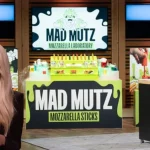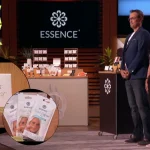
Milk is rich in nutrients and protein; in fact, it is considered a complete food. Although not everybody is tolerant of milk consumption, Slate milk is the perfect alternative that gives you the benefit of real milk but not the discomfort of lactose.
Slate was founded by two friends, Manny Lubin and Josh Belinsky. The two friends were frustrated by the lack of healthy, adult-friendly beverages in the market. They were driven by their love for the nostalgic taste of chocolate milk.
Slate Milk Highlights
| Aspect | Details |
| Business Name | Slate Milk |
| Founding Year | 2019 |
| Founders | Manny Lubin and Josh Belinsky |
| Product / USP | Utilizes ultra-filtration to remove lactose and reduce sugar |
| Shark Tank Episode | Season 11, Episode 23 |
| Deal Status | No deal secured. All Sharks declined the offer |
| Revenue | $22.9 million as of 2023 |
| Current Status | Active |
Slate makes chocolate milk that is free of lactose and contains no added sugars. Their special process of ultrafiltration takes out lactose and gives creamy, better milk as a result. They use monk fruit and cane sugar in place of artificial sugar to make it even healthier.
Its long shelf life and canning make it even better. It can be stored for about a year without refrigeration and shipped anywhere. The beverages are packed in recyclable aluminum cans, which makes them eco-friendly. The product was designed mainly for millennials.
Slate – Founding Story
Manny and Josh decided to launch their own brand to end their misery and introduce the grown-up world to chocolate milk for adults. They launched Slate in late 2019.
To get started, they raised funds. In 2019, they successfully raised over $105,000 through Kickstarter and Indiegogo crowdfunding campaigns.
Their mission is to provide a healthier alternative to consumers. They aim at making high-protein and low-sugar options available to all.
The company hit one of its biggest milestones in 2024 when it became a sponsor for UFC. Apart from that, they have won many awards and have been featured in magazines and television shows. Slate has sold over 15 million pieces of their product.
What’s on the Slate Menu?
The company falls in the food and beverage sector. It began with the ready-to-drink chocolate milk product. It offers protein-enriched beverages. In 2023, Slate expanded its product line to drink mixes and protein cookie mixes.
Their flagship products are Classic Chocolate Milk and Dark Chocolate Milk. Another product that sells actively through e-commerce and retail is their Mocha Flip / Espresso Chocolate Milk.
Slate makes lactose-free milk that has 9g or even lower levels of sugar using an ultra-filtration process. They strip off fat, sugar, and lactose, making them suitable for even people with lactose intolerance. Their beverages have high protein content, which qualifies them as healthy drinks. Instead of adding artificial sweeteners, they rely on monk fruit and cane sugar.
View this post on Instagram
Unique Features
Some features that make Slate Milk stand out are:
- The products are packed in 100% recyclable aluminum cans and can be stored for up to a year even without refrigeration. They are certified plastic-neutral through rePurpose Global. The company pays attention to sustainability; they use minimal water for cleaning machinery, and water extracted through filtration is sent back to farms.
- Each 12-piece pack costs $46.99. If you opt for a 12-pack plan, it costs $41.99. The brand is positioned as a premium company for health-conscious, on-the-go consumers.
- For services, they offer a subscription service which is more convenient for regular buyers for two reasons: one, it is automatic, and the other, it saves some money. They have a brand ambassador program in which people promote their products through their social media posts, and for every product bought through their link, they earn commissions.
Who’s Drinking Slate? A Look at the Market
Slate targets health-conscious adults, including millennials and fitness enthusiasts. The branding and packaging of the products are made thinking of them. The primary target audience is lactose-intolerant individuals.
Recently, more and more fitness influencers have seen Slate beverages, promoting the products on their channels. With the help of marketing, Slate Milk has been able to secure many achievements. This is what they do:
- The company targets fitness-conscious people, as they seek protein-rich food, especially beverages. It also simply targets people who just want to switch to a milk that is better for them than the traditional one.
- To analyze market size and trends, we first need to place the brand in the right category. Their protein and milk beverage falls into the broader wellness and functional drinks industry. This industry has been growing over the years because of the wave of health awareness spreading through the internet among youngsters and millennials.
- The expected CAGR is 23% from 2020 to 2027. It will reach $5.1 billion in the U.S. Since Slate is sticking with its “real milk-based options” image, it stands out as a drink with traditional taste but with modern health benefits.
- Its USP is high-protein, lactose-free, low-sugar chocolate milk in sustainable packaging, combining nostalgic taste with adult nutrition.
Scaling the Slate Vision
Slate’s production model involves an ultrafiltration process through which they remove fat, lactose, and sugar from milk. Then they add natural sweeteners. They partnered with family-owned farms for their dairy demands. The farms are in New York.
Their capacity to scale is wonderful since they have shown impressive growth in the past years. Some of their achievements are:
- When they first appeared on Shark Tank with zero sales, they had sold 15+ million cans by July 2024.
- They hit $40 million in lifetime revenue.
- They expanded from just online sales to now being in 5,000+ retail stores.
- Their products are also in gyms and fitness centres.
Slate’s supply chain is clean and transparent. Their dairy supply is taken from the New York farms, and water is sent back for better usage. Packaging is 100% recyclable. Their partnership with rePurpose Global helps offset plastic.
In terms of future scalability potential, it is safe to say that the brand could scale its business with little to no barriers. They have previously raised funding over and over again and were successful in growing their business. That shows that their business models and partnerships work out great.
Who Should Try Slate Milk?
People who are looking for a nutritious beverage can try it. Busy individuals who don’t have much time to prepare healthy food for themselves. Health-conscious people who want to avoid lactose and sugar. For example:
- Fitness enthusiasts & athletes who are generally careful with their diet.
- Busy professionals & students.
- Chocolate milk lovers generally like the taste of Slate Milk.
- Lactose-intolerant individuals.
- Health-conscious consumers.
- Parents can consume it themselves or provide it to their kids.
- People on the go who need prepared food items.
The Pros and Cons of Slate Milk
These are certain aspects that people look at while considering Slate Milk:
| Aspect | Pros | Cons |
| Protein Content | High protein (20g per can), great for recovery and satiety | — |
| Sugar | Zero added sugar, very low total sugar (~1g) | May taste less sweet to those used to sugary drinks |
| Lactose | Lactose-free, suitable for lactose-intolerant individuals | — |
| Shelf Stability | Shelf-stable (no refrigeration needed until opened) | — |
| Calories | Low calorie (~120–150) per can | — |
| Flavor Options | Coffee-infused options for caffeine and protein in one | Not suitable for those avoiding caffeine |
| Ingredients | Clean label, i.e., no artificial flavors or preservatives | — |
| Packaging | Sleek, modern branding in aluminum cans | Not resealable, therefore, must consume or transfer after opening |
| Availability | Convenient online ordering, and can be found in some fitness stores | Limited retail availability compared to mainstream brands |
| Price | — | More expensive than regular chocolate milk or protein shakes (~$2.50–$3.50) |
How Slate Makes Money
Slate’s revenue streams are spread across both online and offline methods. Their direct-to-consumer sales come through their website. They make retail sales through major chains like Whole Foods, Target, Publix, Harris Teeter, etc.
The pricing structure has evolved over time. Earlier, the cost of the 12-piece pack was less; now, each of those packs costs $46.99. The brand is positioned as a premium company for health-conscious, on-the-go consumers, and it competes against protein shakes and specialty lattes.
They have varied distribution channels. Apart from their official website and retail stores, they are also found in gyms and fitness centres, and are sold on platforms like Amazon.
Partnerships of Slate run very smoothly. They source their dairy requirements from family-owned farms. For plastic-neutral certification, they partnered with rePurpose Global. They have investor partners who invested money in various funding rounds. They also gained UFC sponsorship in 2024.
View this post on Instagram
Top Highlights from Slate Milk Reviews
This is an overview of what people are saying about Slate milk. Here is a snapshot of reviews:
| What We Like | What Could Be Better |
| A high-protein, lactose-free option for those with dietary restrictions is great. | More expensive than regular milk |
| It has a variety of delicious, unique flavors. | Some people may find the protein taste slightly strong. |
| It is in a convenient, ready-to-drink format | Not available in all regions or stores, so that is an area to work on. |
| Lower sugar content compared to traditional flavored milk. | Limited size options for some flavors. |
| The beverage is perfect for post-workout recovery or as a healthy snack. | It might not be suitable for those who prefer non-dairy milk options |
| It has a modern packaging that appeals to a younger audience. | Some flavors may be too sweet for certain tastes. |
| No refrigeration required until opened, making it travel-friendly | — |
Slate’s Funding Journey
Slate started by raising over $100,000 through crowdfunding to launch their product. They then secured millions in seed funding to expand their store distribution and product range, adding drink and cookie mixes.
A later $10.3 million investment is being used for nationwide expansion, new product launches, and marketing deals, including a UFC sponsorship. While the exact ownership is unknown, the founders have likely maintained a good portion of the company, with various angel investors and venture capital firms also involved.
Slate’s Financial Highlights
Slate has experienced large-scale growth. It reported a 300% increase in sales from 2020 to 2021. It most likely achieved similar growth in 2022. Their fast-paced expansion into 10,000 retail locations by the end of 2023 suggests a significant sales volume. However, specific cumulative figures have not been publicly disclosed.
By July 2024, the company announced it had sold over 15 million cans, indicating strong consumer demand and distribution success. Based on these sales, their estimated lifetime revenue exceeds $40 million, showcasing substantial market penetration.
With over $40 million in lifetime revenue and more than $15 million in funding, Slate likely holds a multi-million-dollar valuation. However, the precise net worth of the company remains undisclosed.
Standing Out Among The Competitors
The wellness and functional drinks industry is very competitive due to the growing interest of customers in healthy drinks. Ready-to-drink brands like Nesquik, YooHoo, and Fairlife are Slate’s direct competitors.
| Attribute | Slate Milk | Nesquik | YooHoo | Fairlife |
| Type | Ultrafiltered dairy | Flavored dairy milk | Chocolate-flavored drink (non-dairy) | Ultrafiltered dairy |
| Protein (per 11 oz) | 20g | 8g | 1g | ~13g (per 8 oz) |
| Sugar Content | ~1g total, 0g added | Includes some added sugar | Small amount, but mostly added | Small amount of natural sugar |
| Sugar Type | Natural (from milk, filtered) | Added cane sugar + lactose | High Fructose Corn Syrup | Natural (lactose) |
| Lactose-Free | Yes | No | N/A (not real milk) | Yes |
| Shelf-Stable | Yes | Yes (bottled versions) | Yes | No (requires refrigeration) |
| Key Selling Point | High-protein, no sugar, adult-focused | Sweet, nostalgic, kid-friendly | Sweet drink, not actual milk | High-protein, low-sugar dairy |
Apart from them, the brands that offer lactose-free milk with different flavors are also a threat to Slate. Their indirect competitors include Orgain, Premier Protein, and even energy drinks.
Slate’s special technique to filter out milk gives them an edge over the competition. Their 17–20g protein per can composition wins them consumers who prefer health-focused beverages.
Their sustainable packaging makes them appealing to environmentally conscious customers. Plus, the long life of the product adds value.
There are certain barriers that the new, blooming competitors face. These entry barriers include the complex production process of Slate, which is not easy to replicate. They would need a huge amount of money to scale their business up and out as Slate did.
Building trust among both customers and retailers could take time.
Slate’s Marketing Moves
Slate has various marketing channels, from direct-to-customer to retail store partnerships. Online sales come from either their website or platforms like Amazon. Offline sales come from major brick-and-mortar stores, fitness centers, or gyms. They also relied on crowdfunding to fuel their boost. The marketing strategy of Slate:
- The brand is positioned as a premium health-oriented beverage company. Their conscious image comes from their healthy, protein-rich products. It is also branded as a clean, sustainable company that offers better-for-you alternatives to milk.
- They use influencers and social media advertising to promote their brand. The company follows fitness trends, and they feature fitness influencers to endorse their beverages. They secured endorsement by UFC sponsorship in 2024.
- Slate connects with its customers in a few key ways: they started by building a community of loyal fans through crowdfunding, who helped shape the product. Their direct-to-customer model allows them to form customer relationships.
- Their online presence also helps them form a closeness with their customers.
View this post on Instagram
People, Partners & Processes
Slate’s operations are led by co-founders Josh Belinsky and Manny Lubin, with Michael Arnold heading retail sales. A 12-member sales team drives market expansion and retail partnerships.
While manufacturing partners remain undisclosed, milk sourcing comes from partner farms. Their customer service team focuses on resolving inquiries and maintaining customer satisfaction.
Innovation and Expansion
The product innovation of Slate helped it gain the trust that it has today, fueling its growth. Initially, their product did not appeal to many because of its taste, but over time, they improved it and added some flavors as well.
The company saw successful channel expansion; it spread its retail store connectivity and broadened its online presence.
Proven Success with Awards, Appearances & Advocacy
The company Slate has seen many rewarding milestones. They’ve been honored with rewards like the Forbes 30 Under 30 (2022), which featured both co-founders, Manny Lubin and Josh Belinsky. They were recognized by BevNET as a Rising Star for their company in the beverage industry.
Slate Milk has been featured on television as well. They came on Shark Tank, which gave them massive exposure. The company left footprints on big platforms, like Business Insider and Yahoo Finance.
Slate has a high rating among customers on Amazon, showing that people are satisfied with the product and that they will most probably come back to it.
They have a great social media presence and often repost user-generated content on their profile. Influencers like fitness trainers or gym enthusiasts regularly post about Slate milk, suggesting that their audience get on board.
What’s Next for Slate?
The future of Slate milk looks something like this:
- Slate is aggressively growing. For their short-term plans, they’re aiming to be in three times as many stores across the country this year. They’ve also expanded beyond just canned drinks, now offering drink mixes and protein cookie mixes.
- To boost their brand, they’ve partnered with the UFC. This is done with the hope of reaching more people interested in fitness and healthy living.
- Their long-term plan is to become a leading health beverage brand.
- They are considered a better-for-you chocolate milk brand, and they aim to be the face of the niche. With their sustainable packaging practices, they could be the eco-conscious industry leader.
The ongoing development of the business and the product focuses on growing the product line and launching new variants. - The anticipated challenges for Slate include the rising competition from functional drinks. In order to stand out from the crowd, the brand would need to continue innovating. They would need a strong branding strategy that suits the evolving market.
- The market trends completely depend on consumers’ preferences. Over the years, customers have grown an interest in healthier indulgences. They want nutritional qualities in the beverages that they regularly drink.
- People are increasingly buying high-protein drinks and prefer sustainable packaging. Companies that sell both online and in stores have an advantage in today’s market.
FAQs
1. What is Slate Milk made of?
Slate Milk is ultrafiltered milk. It uses monk fruit extract as a sweetener.
2. What happened to Slate after Shark Tank?
The company, Slate, has been growing ever since it appeared on Shark Tank. They have added new flavors to their product list. They are currently using influencer marketing.
3. Who are the founders of Slate Milk?
Josh Belinsky and Manny Lubin are the co-founders of Slate Milk.













